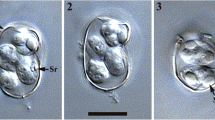Abstract
Coprological examination of 40 Apodemus mystacinus Danford and Alston 1877 from Jordan revealed oocysts of three species of genus Eimeria. Two species are described as new. Eimeria zuhairamri sp. n. has broadly ellipsoidal oocysts 29.6 (27.0–34.0)×23.3 (22.0–25.0) μm with distinctly granulated wall and oocyst residuum. Endogenous development occurs in jejunum and ileum. Eimeria alorani sp. n. has oocysts 26.9 (23.0–29.0)×19.3 (18.0–22.0) μm with smooth wall and absent residuum. Endogenous development is confined to the caecum. The third species, developing in jejunum, has oocysts morphologically indistinguishable from Eimeria uptoni. The identity of E. uptoni and the taxonomy of Eimeria of Apodemus are discussed.




Similar content being viewed by others
References
Al-Eisawi DM (1985) Vegetation in Jordan. In: Hadidi A (ed) Studies in history and archaeology of Jordan. Vol. 1. Department of Antiquities, Amman, pp 45–47
Amr ZS, Abu Baker M, Rifai L (2004) Mamals of Jordan. Denisia 14:437–466
Arnastauskiene T, Kazlauskas J, Maldziunaite S (1978) On the natural groupings of the intestinal parasites of mouse rodents of the preserve of Kamsa and their dependence on host biotope, species and its population structure (In Russian). Acta Parasitologica Lituanica 16:15–32
Couch L, Blaustein L, Duszynski DW, Shenbrot G, Nevo E (1997) A new coccidian from Acomys cahirinus Desmarest, 1819, from Evolution canyon, Lower Nahal Oren, Mount Carmel, Israel. J Parasitol 83:276–279
Glebezdin VS (1973) Coccidial infestation of the wood mouse (Apodemus sylvaticus L.) in the Kara-Kala region of the Turkmen S.S.R. Izvestya Akademy Nauk Turkmenskoi SSR (In Russian). Seriya Biologicheskika Nauk 4:57–62
Higgs S, Nowell F (1991) A review of the species of Eimeria infecting hosts in the genus Apodemus. Systematic Parasitol 20:203–209
Higgs S, Nowell F (2000) Population biology of Eimeria (Protozoa: Apicomplexa) in Apodemus sylvaticus: a capture/recapture study. Parasitol 120:355–363
ICZN (1999) International code of zoological nomenclature, 4th edn. London, The International Trust for Zoological Nomenclature
Levine ND, Ivens V (1965) The coccidian parasites (Protozoa, Sporozoa) of rodents. The University of Illinois Press, Urbana
Lewis DC, Ball SJ (1983) Species of Eimeria of small wild rodents from the British Isles, with descriptions of two new species. Systematic Parasitol 5:259–270
Liu X, Wei F, Li M, Jiang X, Feng Z, Hu J (2004) Molecular phylogeny and taxonomy of wood mice (genus Apodemus Kaup, 1829) based on complete mtDNA cytochrome b sequences, with emphasis on Chinese species. Mol Phylogenet Evol 33:1–15
Musaev MA, Veisov AM (1965) The coccidia of rodents in the USSR. Izvestiya Akad Nauk A SSR (In Russian)
Nowak RM (1991) Walker’s Mammals of the World, 5th edn. The Johns Hopkins University Press, Baltimore and London
Nowell F, Higgs S (1989) Eimeria species infecting wood mice (genus Apodemus) and the transfer of two species to Mus musculus. Parasitol 98:329–336
Pellérdy LP (1974) Coccidia and coccidiosis, 2nd edn. Paul Parey, Berlin und Hamburg and Akadémiai Kiádo, Budapest
Poulin R (1998) Evolutionary ecology of parasites. Chapman& Hall, London
Wash CD, Dyszynski DW, Yates TL (1985) Eimerians from different karyotypes of the Japanese wood mouse (Apodemus spp.), with descriptions of two new species and a redescription of Eimeria montgomeryae Lewis and Ball, 1983. J Parasitol 71:808–814
Acknowledgement
We are deeply indebted to D.W. Duszynski and S.J. Upton for kind help with collecting pertinent literature. The field work in Jordan was generously supported in part by the Higher Council of Science & Technology/Badia Development and Research Project (Animal Biodiversity). We are grateful for the continuous support of Mohamed Shahbaz, director of the Badia project. Research in Dibbin was facilitated by the Royal Society for Conservation of Nature, we are indebted to all members of its “fauna team” for help and to Mayas Quarquaz for collecting the part of samples. We are most indebted to Z. Amr for his endless support and hospitality. We are also grateful for logistic support provided by Mutah University and thank Ratib Al-Oran, Pavel Široký and Stephan Weigel for joining us in the field. The study was supported by grant No. 524/03/1548 of the Grant Agency of the Czech Republic.
Author information
Authors and Affiliations
Corresponding author
Rights and permissions
About this article
Cite this article
Hůrková, L., Baker, M.A., Jirků, M. et al. Two new species of Eimeria Schneider 1875 (Apicomplexa: Eimeriidae) from the broad-toothed field mouse, Apodemus mystacinus Danford and Alston 1877 (Rodentia: Muridae) from Jordan. Parasitol Res 97, 33–40 (2005). https://doi.org/10.1007/s00436-005-1353-3
Received:
Accepted:
Published:
Issue Date:
DOI: https://doi.org/10.1007/s00436-005-1353-3




